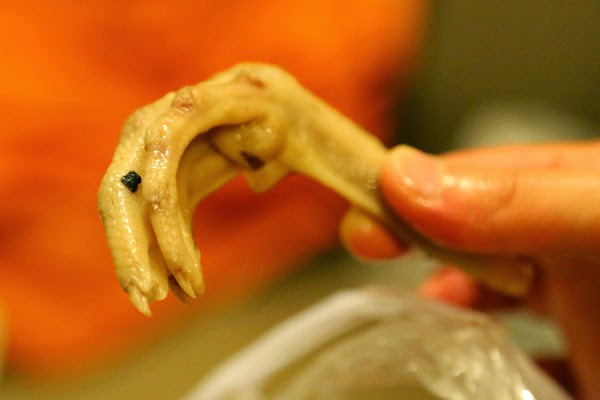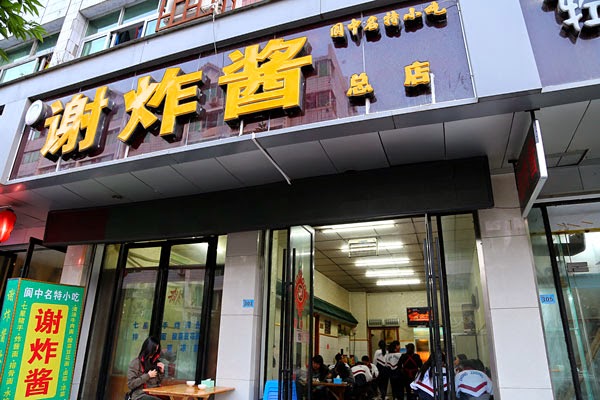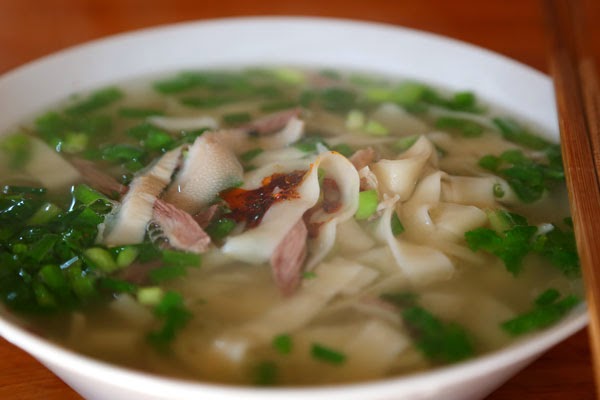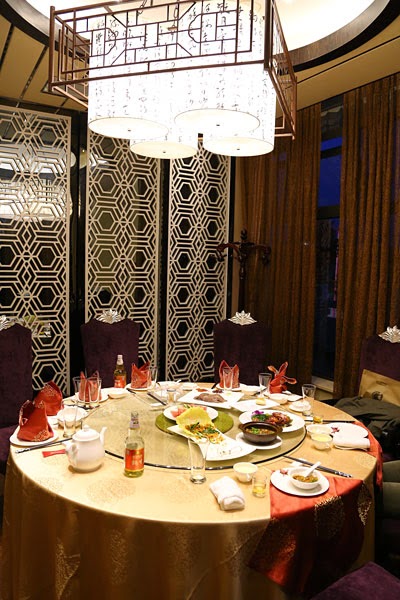
This is one of China's highly underrated tourist destinations, a 2300-year-old ancient city tucked away in remote northern Sichuan, boasting a stunning medieval townscape and a great number of private scholar's mansions from the Ming Dynasty, now slowly opening up to foreigners as guesthouses.

Qing Dynasty streets worthy of movie sets, sincere and friendly townspeople and great food at prices cheap even for the local Chinese ... it's a dream for independent travelers like us. The Ancient City of Langzhong was one of the definite highlights in our trip to Chengdu.

Many travelers have heard of
Pingyao and Lijiang, two of China's best-preserved ancient cities both rightfully crowned as UNESCO World Heritage Sites.
Pingyao is in fact one my favorite places in China, which was why I had been looking forward to yet another of the so-called Four Famous Ancient Cities, this time in the Southwest.

Langzhong is certainly not a household name outside of Sichuan Province. Most Chinese won't know where it is, and during our 2-night stay we saw ZERO foreigners. Somehow the old town has successfully preserved its 400-year-old courtyard mansions and still remains relatively unknown to outsiders, even in the Internet Age.

This anonymity is not surprising -- as of 2014 Langzhong is still not on the national rail network, and few outsiders know about the new G75 expressway which has shortened the trip from Chengdu to 3 hours, close enough for a weekend trip. There's really no excuse not to visit Langzhong anymore, especially for those seeking a Pingyao-like experience around Chengdu.

So one morning we took a highway bus from Chengdu's North Gate Bus station and arrived in Langzhong around noon, in time to check into our Ming Dynasty guesthouse located deep within the historic quarters, surrounded by blocks upon blocks of other Ming and Qing Dynasty residences.

Stepping past the Paifang gate was akin to entering a time machine. We found ourselves walking into the 1800's again, and it felt like a déjà vu from our time in
Hongcun or Eastern China's
Waterfront Towns a couple years back.

For the next two days we strolled the centuries-old alleys alongside the locals, taking their advices for the best breakfast joints and generally fitting into the local life as much as we possibly could. We had a great time, and here are our notes from the trip.
 Sightseeing Notes:
Sightseeing Notes:My biggest recommendation on sightseeing is ... forget most of the official sights and museums.
Officially the top 3 sights are supposed to be the Zhangfei Temple, Gongyuan (Examination Hall) and Wenmiao (Confucius Temple). IMHO the Zhangfei Temple isn't worthwhile unless you're a die-hard Romance of the Three Kingdoms fan; the Confucius Temple is a 21st Century reconstruction; and the Examination Hall isn't wildly fascinating unless you have a penchant for the inventive methods of cheating displayed. The Fengshui Museum and other minor museums aren't even worth mentioning.
In my view, the best sight in Langzhong is simply this ...

... the ancient city itself! This is NOT a museum, but a 2300-year-old commune that still wakes up to the smell of fried dumplings in the morning, practices Taichi in the park then sends the grandkids to kindergarten, all within the historic quarters.

It's a glimpse of Old China at its best -- not a gentrified enclosure in the model of
Wuzhen West, but a genuine slice of a bygone era in an ancient nation racing towards 21st Century urbanization at breakneck pace. You won't see this in Beijing, Shanghai or Chengdu, and that's what makes Langzhong special.

Climbing the two watchtowers is the best way to gain an appreciation for the expanse of the historic quarters. Our favorite was the tower of Huaguanglou at the water's edge, its circular windows looking out towards the hilltop pagodas across the Jialing River.

Our other favorite spot was the top of the South Gate for a panorama of the city's medieval skyline. By the way, the South Gate and its surrounding city walls are open 24 hour a day free of charge, great for romantic strolls after dark above the lit-up roofs.

Just south of Huaguanglou a tiny ferryboat carries local foot passengers across the Jialing River for a cheap RMB 2 (CAD$0.3) and drops off at the so-called Old Town of Nanjinguan. Make no mistake -- it's mostly a 21st Century reconstruction associated with a real estate development. We did check out the prices: RMB 700,000 (CAD$123,000) for a fashionable 3-storey modern-Asian house with a rooftop patio and a small garden.

Hiking up from Nanjinguan we scaled the local foothill of Jinpingshan for panorama views of Langzhong, cradled on three sides by a near-circular loop of the Jialing River. It reminds me somewhat of Cesky Krumlov, but on a much larger scale.
Here is a panorama shot taken by my wife. The ancient city is at the centre, the serpentine river around it.
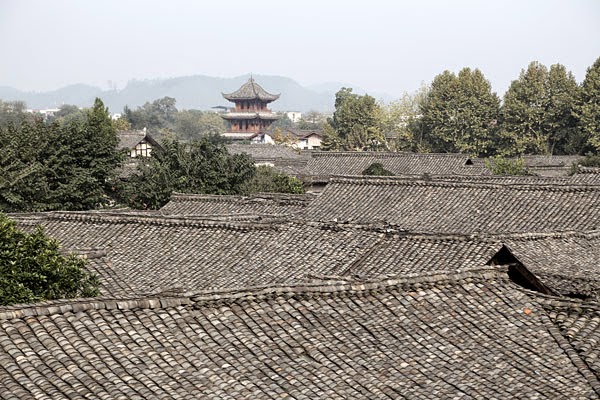
The hike took us about 2 hours roundtrip before we returned to the ferry pier. That was the only excursion we took in Langzhong's surroundings aside from our failed attempt to visit the historic mosque of Babasi, a quick RMB 10 taxi ride from city centre but was closed on the day of our visit.
 Comparison with Pingyao:
Comparison with Pingyao:I can't help making comparisons between Langzhong and Pingyao, two of the best preserved ancient cities in China.
Pingyao is still my favorite among China's historic cities, but Langzhong has its own unique charm as well.

Langzhong won't match Pingyao in terms of completeness as an enclosed ancient city -- only a small section of its medieval city wall remains, and the eastern and northern neighborhoods are immediately bordered by modern concrete blocks. It's never going to match Pingyao in terms of
medieval monuments either, but there is one area where Langzhong does better than Pingyao ...

Langzhong is IMHO less commercialized compared with Pingyao, and by most accounts much better than Lijiang in this aspect. Most shops in the historic quarters are local businesses servicing locals, like this clinic specializing in treating hemorrhoids.

Funeral garbs for the dead, acupunctures for indigestions and an afternoon at the Mahjong parlour are among things you could purchase ... it's timeless and authentically Sichuan in its own exotic way.

Not very environmentally friendly I know ... but we couldn't resist the romance of setting fly a Sky Lantern at the birthplace of Sky Lanterns.

The words "Guards of the Ancient City" watches over the local police detachment. Would I recommend Langzhong over
Pingyao for independent travelers to China? Not quite. But if you're visiting Sichuan and find Pingyao too distant, Langzhong is probably the 2nd best-preserved ancient city of the Han Chinese people and it's a shame to miss.
 Accommodation Notes:
Accommodation Notes:If you've made it this far into remote Southwestern China, you might as well skip those bland westernized hotels and immerse fully by staying at a 400-year-old scholar's mansion. After all you won't find this experience in most cities in China, and certainly not in metropolitan Chengdu.

These were the extravagant manors of prominent government officials or wealthy merchants, constructed during a golden age when Langzhong used to be the major crossroad north of Chengdu and south of Xi'an. Many date from the 17th Century, about the same age as Versailles.

As Langzhong became gradually relegated to the provincial backwaters, the old town largely escaped the appetite of modern real estate developers and happened to be preserved to this date, almost by sheer luck. Chengdu in comparison has basically lost all of its Qing Dynasty neighborhoods.

It's a near miracle that most of these mansions remain privately owned by descendents of the original clans after four centuries, even through Land Reforms of the 1950's and the latter Cultural Revolution, not to mention various warfare over the past 150 years.

Fast forward to the 21st Century and these mansions have all become protected historical monuments, heralded by the local government as a tourism draw. Descendents of the clans suddenly found themselves sitting on top of gold mines ... or at least copper mines. In any case, the owner's family would get a reliable income renting out spare rooms to travelers for about RMB 150 (CAD$27) a night.

It's only recently that foreigners like us could officially stay overnight in these unique residences. Some of these mansions may still haven't officially registered as "Hotels for Foreigners" (Shewai Binguan), though travelers rarely get into trouble in this relatively politically stable region.

The mansions are invariably constructed in the form of traditional Chinese courtyard houses, with all the private rooms facing an open courtyard designed as family space. The owners typically reserve the Upper Room (i.e. room at the end of the courtyard) for private use, and rent out the East and West Rooms.

We rented the West Room at one such medieval mansion, the Pushi Zhaidi, or Mansion of the Pu Clan. Our room was graced with a Qing Dynasty bed chamber as well as antique mahogany chairs and a dresser. The door lock itself was a good old wooden dead-bolt.

Our room did come with the modern amenities of a private bathroom with a western-style toilet and shower, air conditioning and interesting enough, an electric mosquito incense burner. I went to the front desk and asked in Chinese whether we could tap into their "wireless internet connection" ... and the owner quipped "You mean our Wi-Fi?" It's more modernized than meets the eye.

My favorite part of the experience was to lie down in the museum-worthy antique bed chamber, ornately carved with auspicious medieval themes such as processions of high ranking mandarin officials or military generals. It's a scene right out of Chinese cinema, and it's a rare privilege to not only touch but to roll around inside a priceless piece of folk art.

In retrospect we did come across other guesthouses that were probably larger and more exquisitely built, at least on the outside. I'm not sure if that would have translated into a more comfortable hotel room, and we were mainly satisfied with ours aside from the wet bathroom floor ... but that's a common issue with most Chinese guesthouses and even many mid-sized hotel chains. RMB 168 (CAD$30) a night was a steal for staying in a 400-year-old historic monument.
 Transportation Notes:
Transportation Notes:If you're coming from Chengdu, go to the North Gate (Beimen) Bus Station and take a highway bus like we did. The bus trip currently takes 3.5 hours and drops you off at Langzhong's new bus station just south of the city. A taxi ride to the old city cost us RMB 15.
On the way back we made the bad decision of trusting the advice of the locals to try to catch the highspeed train from Nanchong back to Chengdu. The tricky part was that Nanchong was 80 minutes away (not 40 as the locals claimed) from Langzhong, and we crammed ourselves into a shared taxi with the locals for that stretch. We ended up missing the infrequent highspeed train, and had to take a conventional train which gave us no savings in time ... plus much unneeded stress. Take it from our experience -- take the trusty highway bus.
And if you're coming from Chongqing, completion of the Lanzhou-Chongqing highspeed rail in 2016 is supposed to provide a quick and painless connection to Langzhong. But this is China after all, so we shall wait and see.
 Food Notes:
Food Notes:We took LOTS of great tips from the locals on where to eat authentically and cheaply. It was great to discover that food in Langzhong isn't just about its famous marinated beef. This will be covered in the next article.









